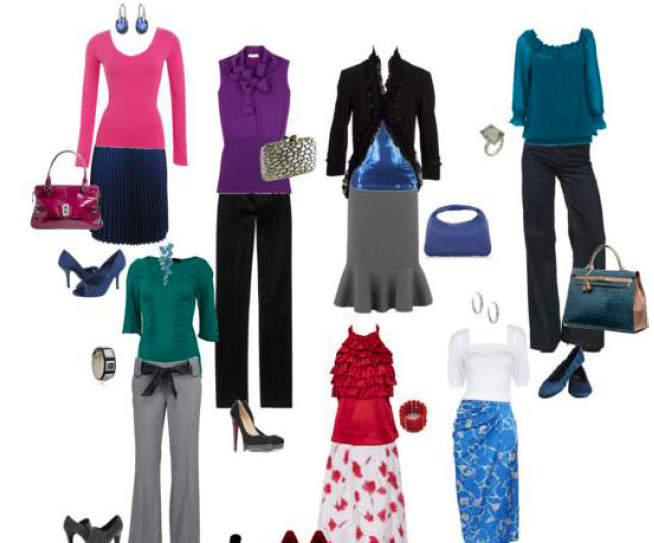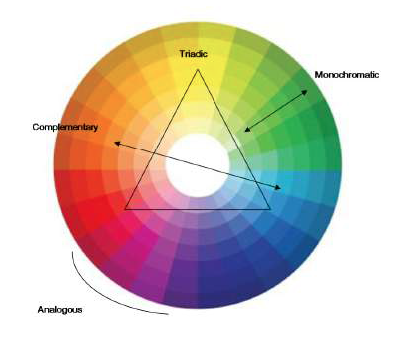WELCOME TO YOUR DRAMATIC PALETTE
examples of DRAMATIC outfits
Your palette is DEEP, COOL and CLEAR.
Your colours are strong and clear. When shopping look for garments which have a strong depth to the colour, are cool and not soft. You want to avoid anything dull or muddy. You will look stunning in an outfit of cool, crisp colours.
USING YOUR COLOUR SWATCH
Rather than throwing out your entire wardrobe out (don’t do that!) from here on in, try to make sure that everything you buy harmonises with the colours in your colour swatch. Longer term, this will ensure that your wardrobe mixes and matches and you’ll know everything suits you too.
To know if a colour is right, place your swatch onto the colour/s or patterns you are looking at. If the colours are similar in intensity and undertone, there is a natural feeling that these colours are from the same colour family and blend. If your swatch stands off or doesn’t harmonise, then the colour you are looking at is not a good match for your swatch.
There are a multitude of colours available to you. Your swatch is just a snapshot guide to the kinds of colours you are looking for. Think of your swatch as an executive summary - there are around 50,000 colours you can happily wear - this is just a small sample to show you the kinds of colours you are looking for. You don't need to match colours exactly.
WEARING YOUR COLOURS
Wardrobe Basics
Neutrals – Black, charcoal, all greys and navy
Interests – Rich raspberry red, magenta, bright aqua, emerald, royal blue, icy blue, teal
Best Denim
Medium to dark indigo
Best Metals
Silver, Platinum, Rose Gold
Best Glasses Frames and Lenses
Silver, pewter, soft grey, red, royal blue, burgundy, black metal and black. Choose frame colours that are from your metals range – silver, platinum, pewter or rose gold, or a metal frame in a cool colour such as blue, purple or even a burgundy. If choosing plastic frames try blue based colours or black. The colour of the lens for sunglasses must be cool, blues and greys or black.
Investment Buys & Accessories
Choose your best neutrals for investment buys. These neutral colours don’t date as quickly as fashion colours.
The best colour for shoes, bags, coats and belts is one that is similar or tones in with your hair colour or is one of your signature colours. This is because you are always wearing your hair and because these items are worn over many other colours and with many outfits, your hair colour is the most versatile colour.
Universal Shoe Colour
When in doubt, and when not toning shoes to the hem of your trousers or matching your tights, choose a shoe in a similar tone to your hair colour to create a pleasing visual loop from face to feet and back to your face. If you want to wear a coloured shoe unrelated to your hair colour, ensure that you repeat the colour in a top or accessory near your face to draw create a pleasing visual grouping effect.
HOW TO WEAR BLACK
Black is a great neutral for you, as your palette includes all the colour properties of black - cool, depth and brightness.
How to Wear Colours that Don’t Fit into Your Colour Palette
If you follow these set of rules you will always look great.
Keep it as far as possible from your face
Wear another colour between it and your skin
Keep the less than perfect colour to only 10 -20% of your entire outfit
Wear it below your waist
Any colour of the same intensity and value as your colouring is easier to wear than one that is markedly different
Use your ideal level of contrast and ideal value in the outfit you are wearing to lessen the impact
Wear a lower neckline
Wear more makeup
Wearing Your Colours Your Way
Not all the colours in your palette may work well worn as a single colour above the waist, so you may need to wear additional colours or garments to add greater interest. For example, whilst your palette may contain light neutrals, these may not look the best in a block of colour on your upper body, however, if teamed with a scarf, necklace, or additional interest colours from your palette, it may work well.
Using the Colour Wheel to Create Colour Combinations
Colour wheel
1. Neutral Plus – wear one or two neutrals with a colour.
2. Monochromatic – colours in the same shade but different lightness or darkness e.g. a variety of blues together.
3. Analogous – 2-3 colours that sit next to each other on the colour wheel, such as green with blue, navy with violet, yellow with orange. Mix back with a neutral from your palette.
4. Triad – take 2 corners of a triad (see colour wheel), such as red and blue, and wear with a neutral to create a great colour combination that is easy on the eye. Great options include violet and green, yellow and blue, green and orange. If you feel really adventurous you can add in the third colour of the triad.
5. Complementary – take two colours that are opposite on the colour wheel such as pink and green and team with a neutral for a bold look.
Always make sure when mixing colours that they are not combined in equal ratios, but instead try the 60/30/10 rule.
Easy Colour Combinations
Here are just a few possible colour combinations to consider when dressing – this list is by no means comprehensive, but may help you think outside your normal colour combining when dressing.
Black – mixes with anything –with a bright colour – a dynamic statement, all black – authoritative, intimidating or creative, with white speaks authority. Mix it with red to be bold, with grey to look industrious. Whilst fuchsia is dynamic, mint green is pensive and sky blue is amiable. Black goes with everything – but remember that how you wear black is dependent on the effect you’re trying to achieve.
Grey – looks great with most other neutrals. Try it with black, brown and other shades of grey. Just be sure the colours are distinct enough to complement each other without blending together and looking muddy. It also works well with colours from violet through to yellow. Grey mixed with a light pink is seen as sociable, lilac is amicable, blue is conservative and a tie in red is energetic.
Brown - mixes well with beige for a relaxed look, red for a dynamic appearance, greens to be restful, blue for calmness and even pink.
Navy – mix it with red and white for an understated look, mauve or violet work well and are a more creative mix Pink looks preppy, a mid blue will create animation, whilst blue stripes are upbeat.
DRAMATIC HAIR
When colouring your hair – for a natural look choose any of the following, or a combination from this list:
Medium Ash Brown
Violet
Dark Brown
Brunette
Black Brown
Blue Black
Black
Avoid adding any warm colour to your hair, be it a highlight in honey blonde or copper, caramel or red. When you are deciding on hair colour, hold a swatch of the colour up to your skin to see if the colour is flattering for your particular skin tone.
DRAMATIC MAKEUP
Foundation: match to skin
Blush: Rose (avoid anything peach or coral)
Eye Shadow: Base - cool beige, slate grey, soft pink
Contour: Cool browns, charcoal, slate blue
Highlight: Silver, champagne, pink
Eyeliner: Deep brown, charcoal, aubergine, navy and forest green
Mascara: Black brown, charcoal, navy
Lipstick: Cherry, plum, raisin, burgundy, raspberry, pinks and soft ruby reds
DRAMATIC PINTEREST BOARD
Click here to see my Dramatic Pinterest board for more inspiration of colour combinations.



















